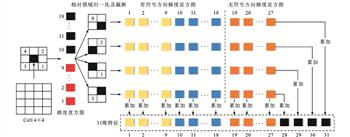| 改进食肉植物算法优化的车辆长期目标跟踪器 |
| |
| 引用本文: | 黄鹤, 李文龙, 杨澜, 王会峰, 茹锋, 高涛. 改进食肉植物算法优化的车辆长期目标跟踪器[J]. 交通运输工程学报, 2023, 23(6): 283-300. doi: 10.19818/j.cnki.1671-1637.2023.06.019 |
| |
| 作者姓名: | 黄鹤 李文龙 杨澜 王会峰 茹锋 高涛 |
| |
| 作者单位: | 1.长安大学 西安市智慧高速公路信息融合与控制重点实验室,陕西 西安 710064;2.长安大学 电子与控制工程学院,陕西 西安 710064;3.长安大学 信息工程学院,陕西 西安 710064;4.长安大学 能源与电气工程学院,陕西 西安 710064 |
| |
| 基金项目: | 国家重点研发计划2021YFB2501200 国家自然科学基金项目52172379 国家自然科学基金项目52172324 陕西省重点研发计划2021SF-483 中央高校基本科研业务费专项资金项目300102323501 中央高校基本科研业务费专项资金项目300102323502 |
| |
| 摘 要: | 
研究了群体智能算法与目标跟踪相关的机理,提取了跟踪区域快速方向梯度直方图(FHOG)作为特征模板,利用食肉植物算法在图像搜索区域搜寻目标位置,基于巴氏距离作为模板匹配的相似度函数设计了一种食肉植物算法跟踪框架;考虑到实际跟踪过程的遮挡、背景杂乱等复杂状况,设计了一种短期记忆模块来预测跟踪过程中食肉植物算法的初始化个体,该模块采用高斯分布方式,利用视频序列前2帧中目标位置来预测运动轨迹;为更好地利用食肉植物算法优化目标跟踪,在迭代过程中设计了一种随机跟随策略与种群划分机制,并作为搜索策略引入跟踪框架中;为弥补方向梯度直方图单特征对目标的表述能力不强的问题,在FHOG基础上融合了ResNet-50中的Conv2-1与Conv4-1两层特征,并在融合特征的基础上设计了一种自适应学习率动态更新模板;在种群维度上添加二维比例感知因子,使得目标窗口的长宽比各自变化,更好适应目标窗口的尺度变化。
研究结果表明: 随机跟随策略和种群划分机制的引入显著改善了食肉植物算法的迭代速度和寻优能力;融合特征和自适应模板更新增强了目标特征表述能力, 解决了由于遮挡等情况学习到大量无效信息,从而导致特征模板退化的问题;算法在跟踪UAV123中几个具有挑战性的车辆视频序列时性能优越,精确度和成功率分别为0.81和0.58,速度为每秒11.05帧;与同类算法相比,跟踪精度和鲁棒性均有大幅提升,能够适应复杂场景中的环境变化,对目标车辆长期保持稳定跟踪。

|
| 关 键 词: | 智能交通 目标跟踪 长期车辆跟踪 群体智能算法 食肉植物算法 特征提取 相似度函数 比例感知 |
| 收稿时间: | 2023-05-21 |
|
| 点击此处可从《交通运输工程学报》浏览原始摘要信息 |
|
点击此处可从《交通运输工程学报》下载全文 |
|



